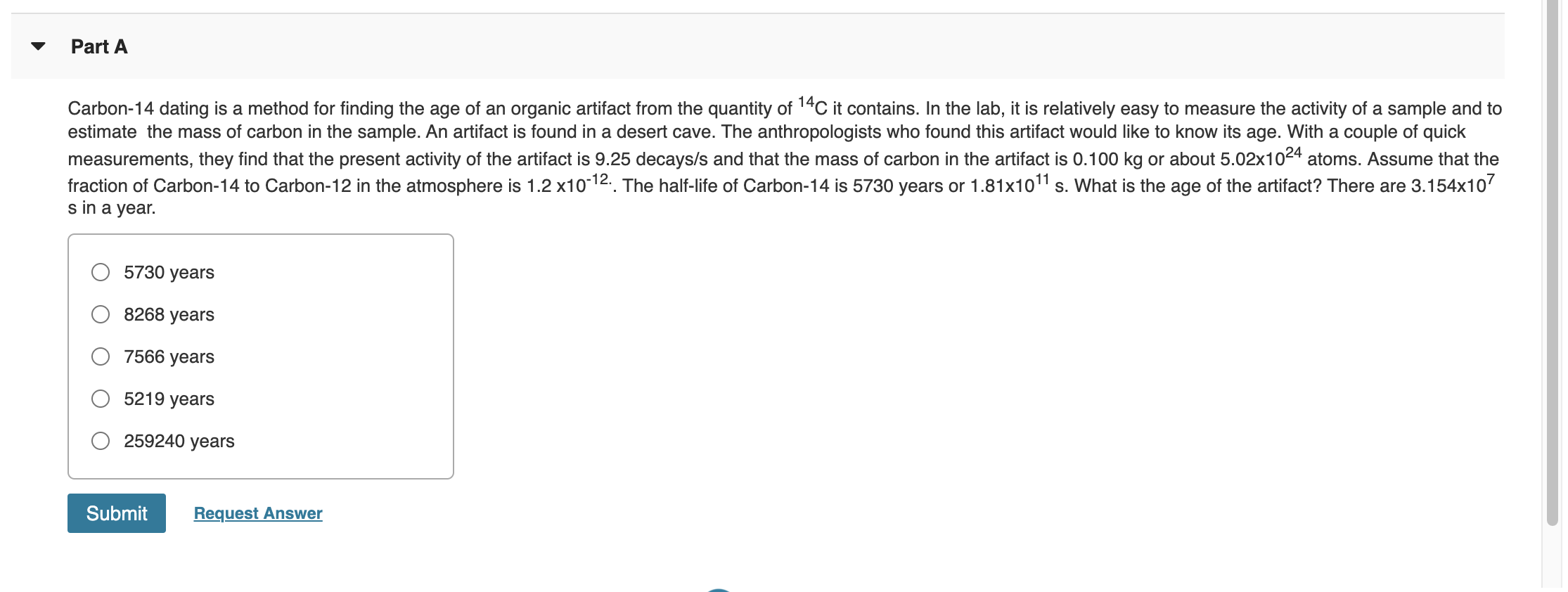Carbon-14 dating is a method for finding the age of an organic artifact from the quantity of 14C it contains. In the lab, it is relatively easy to measure the activity of a sample and to estimate the mass of carbon in the sample. An artifact is found in a desert cave. The anthropologists who found this artifact would like to know its age. With a couple of quick measurements, they find that the present activity of the artifact is 9.25 decays/s and that the mass of carbon in the artifact is 0.100 kg or about 5.02x1024 atoms. Assume that the fraction of Carbon-14 to Carbon-12 in the atmosphere is 1.2 x10-12.. The half-life of Carbon-14 is 5730 years or 1.81x1011 s. What is the age of the artifact? There are 3.154x107 s in a year. 5730 years 8268 years 7566 years 5219 years 259240 years
Carbon-14 dating is a method for finding the age of an organic artifact from the quantity of 14C it contains. In the lab, it is relatively easy to measure the activity of a sample and to estimate the mass of carbon in the sample. An artifact is found in a desert cave. The anthropologists who found this artifact would like to know its age. With a couple of quick measurements, they find that the present activity of the artifact is 9.25 decays/s and that the mass of carbon in the artifact is 0.100 kg or about 5.02x1024 atoms. Assume that the fraction of Carbon-14 to Carbon-12 in the atmosphere is 1.2 x10-12.. The half-life of Carbon-14 is 5730 years or 1.81x1011 s. What is the age of the artifact? There are 3.154x107 s in a year. 5730 years 8268 years 7566 years 5219 years 259240 years
Modern Physics
3rd Edition
ISBN:9781111794378
Author:Raymond A. Serway, Clement J. Moses, Curt A. Moyer
Publisher:Raymond A. Serway, Clement J. Moses, Curt A. Moyer
Chapter13: Nuclear Structure
Section: Chapter Questions
Problem 61P
Related questions
Question
carbon dating

Transcribed Image Text:Carbon-14 dating is a method for finding the age of an organic artifact from the quantity of 14C it contains. In the lab, it is relatively easy to measure the activity of a sample and to
estimate the mass of carbon in the sample. An artifact is found in a desert cave. The anthropologists who found this artifact would like to know its age. With a couple of quick
measurements, they find that the present activity of the artifact is 9.25 decays/s and that the mass of carbon in the artifact is 0.100 kg or about 5.02x1024 atoms. Assume that the
fraction of Carbon-14 to Carbon-12 in the atmosphere is 1.2 x10-12.. The half-life of Carbon-14 is 5730 years or 1.81x1011 s. What is the age of the artifact? There are 3.154x107
s in a year.
5730 years
8268 years
7566 years
5219 years
259240 years
Expert Solution
This question has been solved!
Explore an expertly crafted, step-by-step solution for a thorough understanding of key concepts.
This is a popular solution!
Trending now
This is a popular solution!
Step by step
Solved in 3 steps with 3 images

Knowledge Booster
Learn more about
Need a deep-dive on the concept behind this application? Look no further. Learn more about this topic, physics and related others by exploring similar questions and additional content below.Recommended textbooks for you

Modern Physics
Physics
ISBN:
9781111794378
Author:
Raymond A. Serway, Clement J. Moses, Curt A. Moyer
Publisher:
Cengage Learning

Principles of Physics: A Calculus-Based Text
Physics
ISBN:
9781133104261
Author:
Raymond A. Serway, John W. Jewett
Publisher:
Cengage Learning

Physics for Scientists and Engineers with Modern …
Physics
ISBN:
9781337553292
Author:
Raymond A. Serway, John W. Jewett
Publisher:
Cengage Learning

Modern Physics
Physics
ISBN:
9781111794378
Author:
Raymond A. Serway, Clement J. Moses, Curt A. Moyer
Publisher:
Cengage Learning

Principles of Physics: A Calculus-Based Text
Physics
ISBN:
9781133104261
Author:
Raymond A. Serway, John W. Jewett
Publisher:
Cengage Learning

Physics for Scientists and Engineers with Modern …
Physics
ISBN:
9781337553292
Author:
Raymond A. Serway, John W. Jewett
Publisher:
Cengage Learning

College Physics
Physics
ISBN:
9781285737027
Author:
Raymond A. Serway, Chris Vuille
Publisher:
Cengage Learning

College Physics
Physics
ISBN:
9781305952300
Author:
Raymond A. Serway, Chris Vuille
Publisher:
Cengage Learning

University Physics Volume 3
Physics
ISBN:
9781938168185
Author:
William Moebs, Jeff Sanny
Publisher:
OpenStax